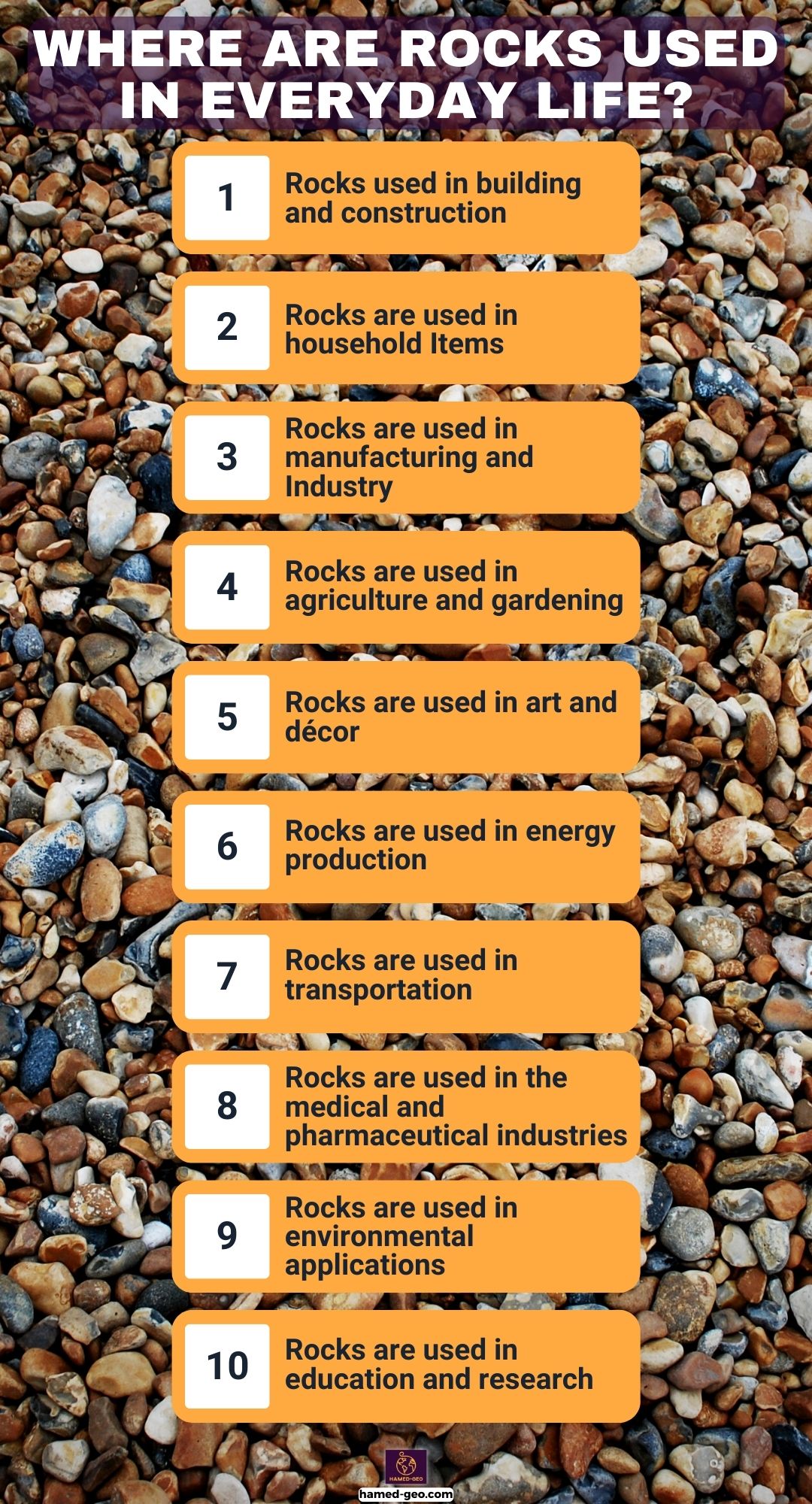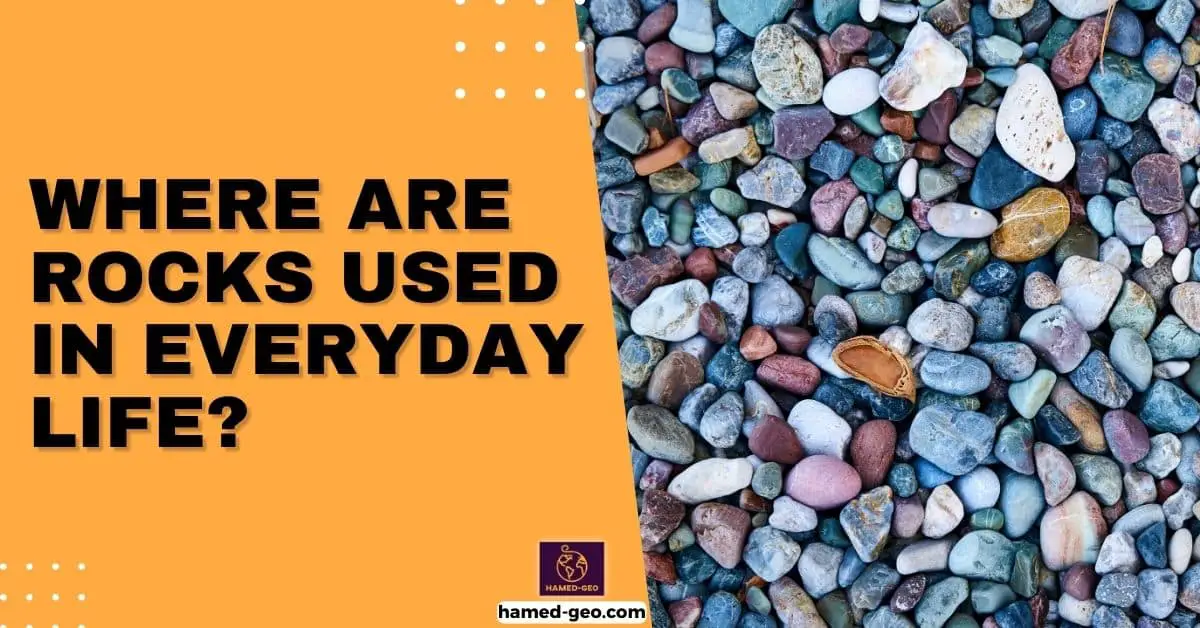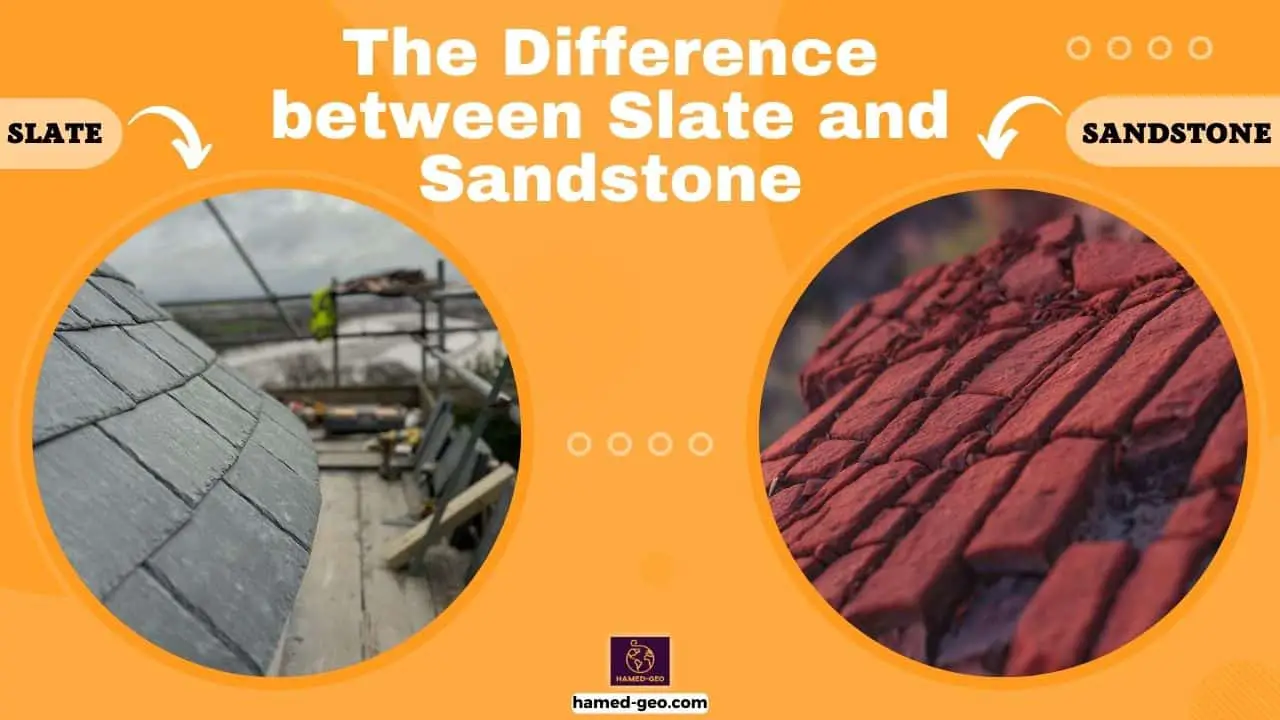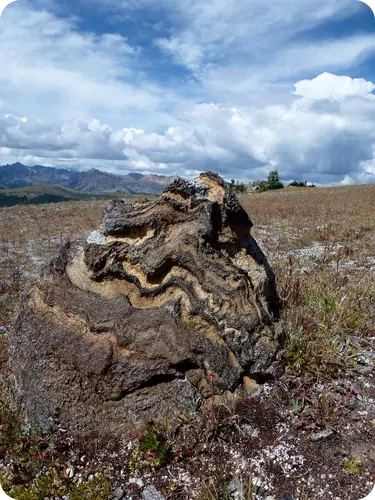Rocks are an essential component of our daily life, and yet most of us take them for granted. From the pebbles on the beach to the mountains in the distance, rocks are all around us. But what are rocks, and why are they so important? In this blog post, we’ll explore the many ways in which rocks are used in everyday life.
What are the rocks?
Firstly, let’s define what rocks are. Rocks are solid, naturally occurring materials made up of one or more minerals. They can be found all over the world, and their composition can vary widely depending on where they are located. Rocks are formed through a variety of geological processes, including cooling and solidification of molten material, pressure and heat, and chemical precipitation.
So why are rocks important in our daily lives? The answer lies in the many ways in which they are used. For example, rocks are used as construction materials, such as in the production of cement and concrete. Rocks are also used as decorative elements in landscaping, as well as in the manufacturing of jewelry and other ornamental objects. Furthermore, rocks are an important source of minerals and metals, which are used in everything from electronics to construction.
The purpose of this blog post is to provide an in-depth exploration of where rocks are used in everyday life.

Rocks used in building and construction
Rocks have been used as a construction material for thousands of years. From the Pyramids of Giza to the modern skyscrapers of today, rocks have played an important role in the construction industry. In this section, we will explore the different types of rocks used in construction and their applications.
Granite, limestone, and sandstone are three of the most common rocks used in construction. Granite is a hard, durable rock that is often used in building facades, bridges, and monuments. Limestone, on the other hand, is a sedimentary rock that is known for its beauty and versatility. It is often used in flooring, walls, and sculptures. Sandstone is a sedimentary rock that is made up of sand-sized grains of mineral, rock, or organic material. It is commonly used in building facades, walls, and paving.
One of the most common applications of rocks in construction is in roads and bridges. Crushed stone, a form of granite, is used to create the base layer of roads, while larger rocks are used to support bridges and other structures. The durability and strength of rocks make them an ideal choice for these types of applications.
Rocks are also used in the construction of buildings. They can be used as a decorative element, such as in the façade of a building, or as a structural element, such as in the foundation or load-bearing walls. For example, the famous St. Paul’s Cathedral in London is made of limestone, while the Empire State Building in New York City is made of granite.
In addition to their practical applications, rocks are also used to create some of the most famous landmarks in the world. The Great Pyramid of Giza, one of the Seven Wonders of the Ancient World, is made of limestone. The Stonehenge monument in England is made of sandstone. And the Mount Rushmore National Memorial in South Dakota is made of granite.
Rocks are used in household Items
Rocks are not just used in construction, but they also play a significant role in our everyday household items. Rocks, especially granite and marble, are used in a variety of household items such as countertops, flooring, and sinks. In this section, we will explore the use of rocks in household items, the advantages, and disadvantages of using them.
One of the most common household items that use rocks is countertops. Granite is a popular choice for kitchen countertops due to its durability, heat resistance, and scratch resistance. Marble, on the other hand, is more porous and prone to stains, making it a better choice for bathroom vanities. Quartz is another popular option for countertops, as it is a man-made material that is made up of crushed quartz and resins, which makes it durable and easy to maintain.
Flooring is another area where rocks are commonly used. Slate, marble, and granite are popular choices for flooring due to their durability and natural beauty. These rocks can be used in various areas of the home, including kitchens, bathrooms, and entryways. Natural stone flooring can also help to keep a room cooler during the summer months, as the rock has natural cooling properties.
Sinks are another household item that can be made from rocks. Granite and marble sinks are popular for their durability and natural beauty. They are also available in a variety of colors and patterns, making them a versatile option for any home.
There are several advantages to using rocks in household items. First, they are incredibly durable and can last for many years, making them a cost-effective choice in the long run. They are also heat resistant, which is particularly useful for items such as countertops that come into contact with hot pans and dishes. Additionally, rocks have natural antimicrobial properties, making them a hygienic choice for items such as sinks.
However, there are also some disadvantages to using rocks in household items. Rocks are porous and can be prone to stains, which can be a concern for items such as countertops and flooring. They also require regular sealing and maintenance to keep them looking their best. Furthermore, rocks are heavy, which can make installation difficult and require additional structural support.
Rocks are used in manufacturing and Industry
Rocks are not only essential in the construction and household items but also in manufacturing and industry. Many products are made from rocks, and various types of rocks are used in manufacturing different items. This section will explore the importance of rocks in manufacturing and industry and the different types of rocks used.
One of the most common rocks used in manufacturing is limestone. Limestone is a sedimentary rock that is primarily made up of calcium carbonate. It is widely used in the production of cement, which is used in construction to make concrete. Limestone is also used to make quicklime, which is used in steel production, and in the manufacturing of glass, paint, and plastic.
Talc is another rock that is widely used in manufacturing. Talc is a soft mineral that is used in ceramics, paint, and cosmetics. It is also used as filler in paper and as a lubricant in various industrial processes.
Rocks are also used in the production of glass. Sand, which is made up of tiny particles of rock and minerals, is the primary ingredient in glass production. Other rocks, such as feldspar and soda ash, are also used in the production of glass.
Paper is another product that is made from rocks. Calcium carbonate, which is found in rocks such as limestone and marble, is used as filler in paper production. This makes the paper more durable and gives it a brighter white color.
Fertilizer is another product that is made from rocks. Phosphate rock is used to make fertilizer, which is essential in agriculture to help crops grow.
The use of rocks in manufacturing and industry shows how versatile and valuable these materials are in our daily lives.
Rocks are used in agriculture and gardening
Rocks play an important role in agriculture and gardening. They are used to improve soil drainage, adjust pH levels, and provide physical support for plants. This section will explore the different types of rocks used in agriculture and gardening and their benefits.
One of the most commonly used rocks in agriculture and gardening is gravel. Gravel is used as a top dressing on garden beds, as a pathway material, and as a base for buildings and walkways. It provides excellent drainage, prevents soil erosion, and allows air to circulate around plant roots.
Crushed rock is another rock commonly used in agriculture and gardening. It is used as a base material for roads and pathways, and as a drainage material for retaining walls and flower beds. Crushed rock is also used to improve soil drainage, as it allows water to flow freely through the soil.
Limestone is another rock commonly used in agriculture and gardening. It is used to adjust soil pH levels, making it more alkaline. This is important because some plants thrive in alkaline soil conditions, while others prefer acidic soil conditions. Limestone also provides calcium, which is important for plant growth.
In addition to improving soil conditions, rocks are also used to provide physical support for plants. For example, rocks can be used to create a border around garden beds, preventing soil from washing away during heavy rain. Rocks can also be used to anchor plants in place, preventing them from toppling over during strong winds.
Using rocks in agriculture and gardening is a sustainable and cost-effective way to improve plant growth and promote healthy soil conditions.
Rocks are used in art and décor
Rocks have been used in art and decor for centuries, from gemstones to sculptures. The unique properties of different types of rocks make them versatile materials for artists and designers. This section will explore the various ways rocks are used in art and decor and highlight some famous examples.
Gemstones are perhaps the most well-known use of rocks in art and decor. Gemstones are minerals that have been cut and polished to enhance their natural beauty. They are used in jewelry, such as necklaces, rings, and earrings, and are valued for their color, clarity, and rarity. Some of the most popular gemstones include diamonds, rubies, sapphires, and emeralds.
Sculptures are another common use of rocks in art and decor. Sculptures can be made from a wide variety of rocks, including marble, granite, and sandstone. These rocks are often carved into intricate shapes and designs, such as statues, fountains, and reliefs. Famous examples of rock sculptures include Michelangelo’s David, the Moai statues of Easter Island, and the Mount Rushmore National Memorial.
Rocks are also used in decors, such as vases, candle holders, and coasters. These items can be made from a wide variety of rocks, including agate, quartz, and onyx. The unique colors and patterns of these rocks make them popular choices for home decor. They can be used as accents in living rooms, dining rooms, and bedrooms, adding a touch of natural beauty to any space.
Rocks are used in energy production
Rocks play a vital role in energy production, providing the raw materials necessary for producing various forms of energy. This section will explore the importance of rocks in energy production, the different types of rocks associated with it, and the advantages and disadvantages of using rocks for energy production.
Sedimentary rocks, such as sandstone and shale, are an essential source of fossil fuels. Fossil fuels are formed from the remains of ancient plants and animals that are buried under layers of sediment and subjected to heat and pressure over millions of years. Coal, oil, and natural gas are all examples of fossil fuels that are used to generate energy.
Coal is a rock that has been formed from the compression and heating of plant material over millions of years. It is a significant source of energy worldwide, providing about 27% of the world’s electricity. However, coal mining and burning can have severe environmental impacts, including air and water pollution and greenhouse gas emissions.
Oil and natural gas are both hydrocarbons that are extracted from underground rock formations, such as sandstone. These fuels are used primarily for transportation and heating. While they are more efficient and cleaner-burning than coal, their extraction and use can also have significant environmental impacts, including air and water pollution and habitat destruction.
In addition to fossil fuels, rocks are also used in renewable energy production, such as geothermal energy. Geothermal energy is generated by harnessing the natural heat of the earth’s crust, which is stored in underground rocks. Geothermal energy is a clean and renewable source of energy, but its use is limited by the availability of suitable geothermal sites.
Rocks are used in transportation
Rocks play a crucial role in transportation infrastructure, providing the necessary materials for constructing and maintaining roads, railways, and airports. This section will explore the various ways rocks are used in transportation infrastructure, the importance of these materials, and the advantages and disadvantages of using rocks in transportation.
Gravel and crushed rock are the most commonly used rocks in transportation infrastructure. They are used in the construction of roads, railways, and airport runways, providing a durable and stable base for these structures. These materials are particularly useful in areas with poor soil conditions or high traffic volumes, where they can help to distribute the weight of vehicles and reduce wear and tear on the surface.
In addition to providing a stable base, rocks are also used in the construction of retaining walls, bridges, and tunnels. These structures are essential for maintaining the safety and integrity of transportation infrastructure, particularly in areas with challenging topography or harsh weather conditions.
While the use of rocks in transportation infrastructure has many advantages, it also has significant environmental impacts. The extraction and processing of rocks can have negative effects on air and water quality, soil stability, and biodiversity. In addition, the transportation of rocks from quarries to construction sites can contribute to greenhouse gas emissions and air pollution.
To mitigate these impacts, there are several strategies that can be employed. These include using alternative materials, such as recycled concrete and asphalt, reducing the need for new rock extraction, and implementing sustainable quarrying practices, such as reclamation and restoration of quarries after extraction.
Rocks are used in the medical and pharmaceutical industries
Rocks play a significant role in the medical and pharmaceutical industries, providing the necessary materials for various medical products and treatments. This section will explore the different types of rocks used in these industries, the products and treatments they are used for, and their advantages and disadvantages.
One of the most common rocks used in the medical and pharmaceutical industries is calcium carbonate. This rock is used in the production of antacids, which are used to neutralize stomach acid and treat conditions such as heartburn and indigestion. Calcium carbonate is also used in the production of calcium supplements, which are used to support bone health and prevent conditions such as osteoporosis.
Another commonly used rock in the medical and pharmaceutical industries is kaolin. This rock is used in the production of various products, including toothpaste, cosmetics, and medical dressings. Kaolin is also used in the treatment of diarrhea, where it is used to absorb excess water and solidify stool.
Other rocks used in the medical and pharmaceutical industries include quartz, which is used in the production of glassware for medical laboratories, and talc, which is used in the production of various medications and cosmetics.
While the use of rocks in the medical and pharmaceutical industries has many benefits, it also has some disadvantages. The extraction and processing of rocks can have negative environmental impacts, and some rocks may contain impurities that can be harmful to human health. To mitigate these risks, strict quality control measures are employed to ensure that only high-quality, pure rocks are used in medical and pharmaceutical products.
The use of rocks in the medical and pharmaceutical industries has significantly improved human health and well-being, and will continue to do so in the future.
Rocks are used in environmental applications
Rocks are not only important in construction, manufacturing, and transportation, but they also play a crucial role in environmental applications, such as water treatment and air purification. This section will explore the different types of rocks used in environmental applications, the benefits of using rocks in these applications, and some examples of environmental applications that use rocks.
One of the most common rocks used in environmental applications is zeolite. Zeolite is a naturally occurring mineral that has a unique ability to adsorb and exchange ions. This property makes it useful in various environmental applications, such as water treatment, where it is used to remove heavy metals and other contaminants from wastewater. Zeolite is also used in air purification, where it is used to remove volatile organic compounds (VOCs) and other harmful pollutants from the air.
Another commonly used rock in environmental applications is limestone. Limestone is used in the treatment of acidic water, where it is used to neutralize the acidity and restore the pH balance. It is also used in flue gas desulfurization (FGD), where it is used to remove sulfur dioxide (SO2) from the emissions of coal-fired power plants.
Other rocks used in environmental applications include activated carbon, which is used in water treatment to remove organic contaminants, and diatomaceous earth, which is used in swimming pool filters to remove impurities from the water.
The use of rocks in environmental applications has many benefits. Firstly, rocks are abundant and readily available, making them a cost-effective solution for many environmental problems. Secondly, the use of rocks in environmental applications is often a more sustainable option than using chemicals or other synthetic materials. Finally, rocks are often naturally occurring and have minimal impact on the environment.
With the growing concern for environmental protection, the use of rocks in environmental applications is becoming increasingly important in ensuring the health and well-being of the planet and its inhabitants.
Rocks are used in education and research
Rocks are not only important in our daily lives but they are also essential for education and research. In this section, we will explore the importance of rocks in education and research, including how they are used in geology and earth science studies.
Geology is the scientific study of rocks, minerals, and the Earth’s physical structure. Rocks are the building blocks of the Earth’s crust and they provide valuable clues about the history of our planet. Geologists use rocks to study the Earth’s composition, structure, and history.
One of the primary uses of rocks in education is in geology courses. Geology students study rocks in detail, learning about their mineral composition, physical properties, and how they are formed. They also learn how rocks are used in various industries, such as construction, manufacturing, and energy production.
Rocks are also used in research to study the Earth’s history and geological processes. For example, geologists use rocks to study plate tectonics, which is the movement of the Earth’s crustal plates. By analyzing the composition and structure of rocks, geologists can learn about the Earth’s past and how it has changed over time.
Another important application of rocks in research is in the study of fossils. Fossils are the remains of ancient plants and animals that have been preserved in rocks. By studying fossils, scientists can learn about the evolution of life on Earth and the history of the planet.
In addition to their use in geology and earth science, rocks are also used in other fields of study. For example, archaeologists use rocks to study ancient civilizations, while astronomers study rocks from other planets and moons to learn about their composition and history.
Rocks are an integral part of our daily lives. From construction to transportation, art to agriculture, rocks are utilized in numerous ways to make our lives easier and more convenient
In conclusion, rocks are an important and versatile component of our daily lives. They are used in construction, landscaping, and as a source of minerals and metals. Without rocks, many of the products and structures we rely on would not be possible. So next time you come across a rock, take a moment to appreciate its importance in our world.



